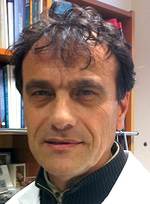Interview Ehrenmitglied
A great surprise
HONORARY MEMBER 2016: Prof. Dr. Bruno Kastler
Centre Hospitalier Universitaire Besancon
An interview with Prof. Dr. Bruno Kastler, appointed honorary member of the DRG at RöKo 2016
When did you decide to go into radiology?
At the end of my residency in 1986 as an internist and cardiologist I had the opportunity to meet Prof. Wackenheim. I asked him if I could use the MRI facilities in his department to continue to perform cardiovascular MRI. He made this short relevant answer: “For you in Alsace or France it may take as a cardiologist 30 years to access an MRI unit without obstacles.” He was quite right, I must admit! It is still not so easy in France. And he continued: “Your alternative choice is to accept to come to my department as a fellow.”
 Prof. Bruno KastlerHave you always wanted to become a radiologist?
Prof. Bruno KastlerHave you always wanted to become a radiologist?
After my medical and physics studies in Marseille in France I passed the ECFMG commission and moved to the USA. My first choice as a medical specialty was cardiology.
As a child I had two, somehow antagonistic, strong wishes: number one was to become a scientist or a physicist like my father and be able to make practical discoveries to improve life, and number two was to become a doctor and move to Africa to help out people in needs. Life gave me the great opportunity to achieved both: train as a physicist and still use this skill in MRI and become an MD with several strong links to Africa and recently South-East Asia.
What do you like most about your profession?
The therapeutic outcomes offered by innovative minimally-invasive interventional procedures. And recently the great opportunity I have been given this year to move to Paris in order to work there.
What do you like least?
Having to cope with an administration when it has no big ambitions or vision of the future.
Who influenced you most during your career and why?
Prof. Wackenheim – neuroradiologist and neuropsychiatrist – a visionary in radiology who gave me the great opportunity as a cardiologist to join his department and become a radiologist (an “imagier de la médecine” as he liked to quote) with a foot still in physics (MR), cardiology (cardiovascular MR) and patient treatment (interventional pain management). Prof. Wackenheim had strong links to Germany and German culture and opened up with Prof. Claus Claussen the German-French radiology cooperation era we have maintained with Prof. Philippe Pereira.
Was there an occasion that influenced you a lot during your career?
The first patient I treated by RFA for two pelvic bones metastasis in 2002. She was 67 years old and was confined to her bed with excruciating intractable pain. The morning after the procedure she was sitting in an armchair besides her bed smiling. She asked me if she may hug me and told me: “Young man”, I was in my mid-40s, “I am almost pain free, you have changed my life”. She left the palliative pain unit within a few days and was able to return to her home.
Furthermore: My experience as a resident in the US in the early 1980s. The American society was so pertinent concerning integration of handicapped people (job opportunity, facilitated access to public services and so on). It felt like being 30 years behind compared to Europe. This strongly contrasted with the great number of patients who did not have proper medical insurance coverage and thus received just “minimal treatments”. I am a strong USA lover where my daughter and two sons were born, but still – that situation back then stunned me.
If you were able to go back in time, would you change anything?
In my career: not much except accept that I maybe should have moved to Paris earlier or to the Northwestern Hospital in Chicago in 2003. Great places, and extraordinary times and experiences.
|
“Snapshot Questions” How does it feel to be an honorary member of the DRG?
A great surprise, an immense pleasure and sincerely an utmost honor for a “career achievement”!
What’s the magic formula for success?
Being gifted and lucky might help, but first and second rule is: Work hard! At best combine pleasure in daily work helping out others which encompasses patient care, but also teaching, founding a radiology school with followers and so on.
What song best describes your work ethic?
Even if it may sound naïve I would still choose “Imagine” by John Lennon because it carries out an immense message of hope.
When are you completely satisfied with your work?
When my patients suffering are relieved from their intractable malignant or benign pain by my interventional techniques and then the quality of their life improves significantly. |



